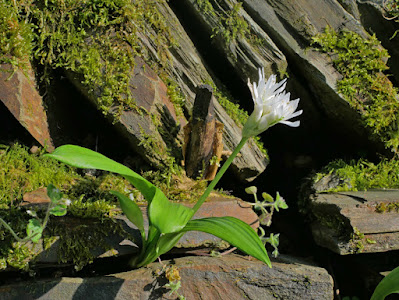Near to Wadebridge is a bog and heath called Rosenannon Downs managed by Cornwall Wildlife Trust. I thought I would visit as I had never seen Bog Myrtle before and it should be in flower. It was only a short drive and as soon as I drove onto the heath, I saw hundreds of Bog Myrtle, flashing like gold specks in the afternoon sun.
As you can see, it is a small woody shrub with golden coloured "cones" that contain the pollen and stigmas.
Myrica gale
It was nice finding something easily for a change!
Here's a habitat photo. The grassy strip by the road is where the Dandelions were found mentioned later on.
I had a walk about to see what else might be flowering. In the damper places I found plenty of Lousewort in flower, a parasitic plant, common in boggy habitats.
Pedicularis sylvatica
One of thousands of Lesser Centaury amongst a carpet of Opposite Leaved Golden Saxifrage.
Ficaria verna and Chrysosplenium oppositifolium
This young rush was coming into flower. I hadn't seen this before, but found it to be the Black Bog Rush, a common plant here. The young inflorescences really were quite dark, which gives the plant its name. The plant eventually forms a large tussock and the black fruits persist into the next season too.
Schoenus nigricans
A very common fern here is the Soft Shield Fern. The fronds have a thumb shaped basal leaf and they run paralell to the stem.
Polystichum setiferum
Along the road verge (see habitat photo for Bog Myrtle above) was a grassy strip, kept short with rabbit grazing. Dotted all over it were Dandelions, so I took a sample to key out at home. This one appears to be Taraxacum brittanicum though I will ask the BSBI Taraxacum referee to confirm this later.
Once home, I noticed a Fumitory growing on bare earth in my garden. The concolourous top petal (all the same colour) means this could only be Tall Ramping Fumitory, a nice find for a garden.
Fumaria bastardii
The next day, I took a late afternoon walk on fixed dunes near Rock. This is a calcareous site, so the flora is completely different to most areas here.
Not much is showing yet, but in the sand dunes were carpets of Rue-leaved Saxifrage, a tiny, sticky plant that turns red with age. If you look at the photo below, notice the moss growing around it. This plant is barely larger than the moss!
Saxifraga tridactylites
There were hundreds of tiny specks of blue in the dunes. These were the flowers of the minute Early Forget-me-not. If you find a flower 2mm across, that's a large one.
Myosotis ramosissima
I then came acrosss a rather attrctive Euphorbia that I hadn't ever seen before. I guessed that it might be Portland Spurge and I later confirmed that it was. The stems were a deep red and it grew on the sand and in cracks in the rocks too.
Euphorbia portlandica
My last photo was of Cornsalad, rather small in this harsh environment. Seeds are need to identify them to species level and it's too early yet for them.
Valerianella
So ended my trip this day. The flora is awakening and soon I won't be able to keep up with what comes into flower. I can't wait!
Blackthorn framing the wonderful scenery that is local to me now.
Prunus spinosa
Take care
Dave
Follow me on Twitter @botany2021

























































